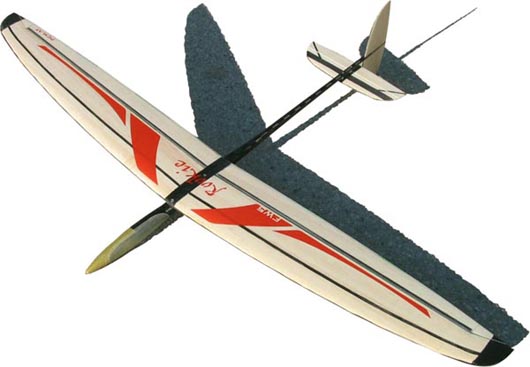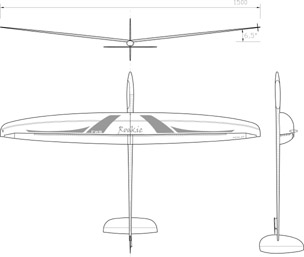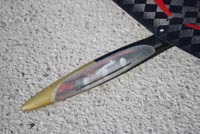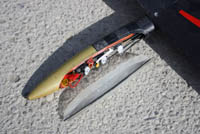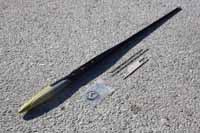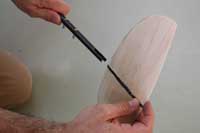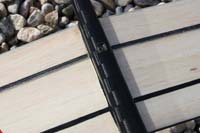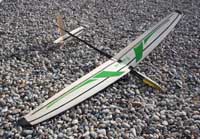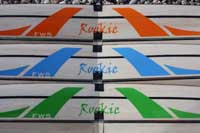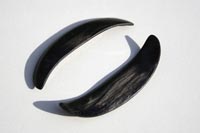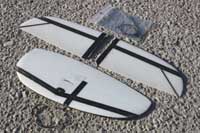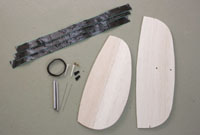| FUSELAGE |
| The
fuselage is identical to the fuselage of FW5 Flow (competition
version). It is produced as sandwich construction
over the whole fuselage with airex und balsa as supporting
material. This high effort in development and production
is rewarded with fantastic weights of nearly 35g
and simultaneously high stiffness. |
The
materials we used are:
-
kevlar in the front for 2.4ghz receivers
- Unidirectional HM carbon in the back for
good stiffness
- airex sandwich in the front and balsa
sandwich in the back for good strength |
|
| The
fuselage is shorter than with our previous models
in the back and the front to center the masses.
Thermalling
characteristics, especially agility and sensitiveness
for tharmals have clearly improved by this. You can
easily stay in the thermal by making small steering movements
or change the turning direction with nearly loosing no height.
|
| Nose
made of kevlar for installation
of 2,4GHz. |
|
| CNC-milled
radio board with access from the side for tidy
mounting and quick changing of servos |
|
| One-piece
fuselage built with unidirectional
HM carbon |
|
| Pre-fabricated
threads for fixing the wing |
|
| The
end of the boom is shaped for easy mounting of the rudder. |
|
| |
|
| WING |
|
| -
Airfoil: Zone airfoils from 52-21. These airfoils
are very suitable for high start and far distance
flights. |
-
Wing geometry:
-
Area: 22,4dm²
- Aspect ratio: 10 |
We
chose again a more wide wing tip like the fw4 has.
We made tests with narrow wing tips to reduce mass at the
tip. The result was bad during flight and also the strength
of the tip decreased extremely. So we had to add more material
to reach enough strength. That means in the end we had more
weight and worse flying performance. So we chose again the
wide tip that circles great and forgives mistakes.
Now you can dare to thermal very low and near to obstacles.
|
-
Wing materials:
| The
wing is built in glass/balsa sandwich construction
with carbon reinforcements and high-modulus carbon
spar. We use 50g glass as an outer layer in order
to achieve a higher rigidity and durability. |
|
| For
joining of the ailerons there are levers to be
hooked in on the downside of the fuselage. The servos
are located in the fuselage. |
|
| Colour
on top and bottom, crossbeams on the bottom for good
visibility. |
|
There
are 4 colours for the wing to choose from: red,
orange, green, blue
White and yellow are also available, but offer poor contrast
on the balsa. |
|
| Ergonomically
designed throwing peg |
|
| |
|
| STABILIZER |
|
| By
default, the kit is sold with tails made of rohacell
core which is coated with glass and strengthened
with carbon strips. |
|
Alternatively,
you can also install cheaper balsa stabs:
The tail consists of two sanded balsaboards with carbon
reinforcements. |
|
Scope
of delivery:
The trailing edge of the balsaboards is pre-sanded.
The nose radius and the carbon reinforcements (enclosed
in the kit) are still to be completed. |
|
| Easy
installation as the boom is pre-shaped for mounting
the rudder. |
|
| The
elevator is dismountable. |
|
| |
|
| ACCESSORIES
(not enclosed in kit) |
|
| 4
pieces of GP NiMH Accu 35AAAH are ideal for the
power supply. |
|
| Protection
bags for
the wing |

|



